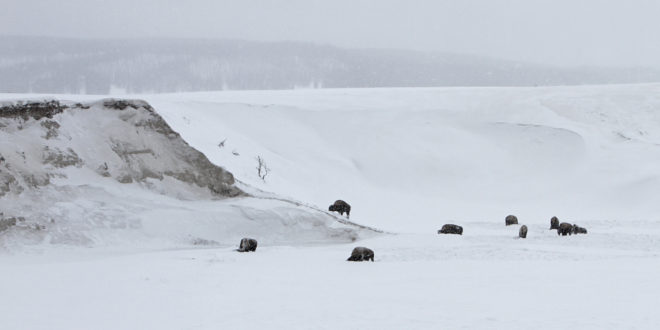In light of this year’s Yellowstone bison population survey, some are questioning the future of Yellowstone’s central herd, nominally untouched by slaughter efforts.
Late last month, we reported Yellowstone’s bison population measured an estimated 4,8000 animals, down from 5,500 bison at the same time in 2016. The shrink in population comes after over 1,200 bison were hunted or slaughtered under this year’s iteration of the Interagency Bison Management Plan.
Yellowstone bison biologist Rick Wallen previously discussed the marked decline in Yellowstone’s central bison herd, which is down 42-48% from the herd count in 2016. The central herd, typically seen around the Hayden Valley, is not a focus of IBMP efforts, which are focused on bison roaming on Yellowstone’s Northern Range and southern Montana.
Wallen, speaking to the Ravalli Republic, predicts that “something really big happened this year to change the distribution dynamic on the landscape.” But what was that change? From the Ravalli Republic:
The first thought was that maybe those central herd animals were disproportionately killed during the winter by hunters outside the park’s boundaries and through the Interagency Bison Management Plan agreement that ships a portion of the herd to slaughter. The winter slaughter program, which donates the animals to tribes for meat, is an attempt to reduce the bison population and slow outmigration from the park into Montana.
Nearly 7,500 Yellowstone bison have been killed since 2000. Yet the park’s bison have, once again, proven to be incredible survivors. Between 2000 and 2016 the population more than doubled, rising from 2,600 to 5,400 animals. Between 2008 and 2017, the northern herd has increased by 275 percent.
“They just know how to survive on our landscape,” Wallen said.
That doesn’t seem to be the case with the central herd, though. Since 2008 that group of bison has exhibited “a lower potential for population growth,” according to Yellowstone’s survey. Maybe they are migrating to the Gardiner area in winter and being slaughtered, killed by hunters, or simply not returning to the central herd’s usual haunts after winter.
Strangely, out of 12 collared central herd bison, 11 survived the winter and six wintered on the western side of the park, not to the north where the slaughter program takes place.
“So it appeared they had high survival,” Wallen said. “It makes you wonder how many migrated to the Northern Range.”
Biologists like Wallen believe Yellowstone bison, being on the whole social animals, tend to easily fill in gaps left by IBMP operations. This apparent desire to stick with the northern herd may explain why the central herd has declined as much as it has. It does not explain, however, why bison are not returning to the Hayden Valley, where they have freer rein to roam.
According to the Republic, Yellowstone biologists plan to put GPS collars on 15 or more additional bison before winter, in order to track their movements. Wallen told the Republic the real question will be how much herd information they can glean from that one collared bison.
Another dilemma facing the central herd is the matter of westward expansion. Under rules promulgated by Montana Governor Steve Bullock, bison are allowed to roam year-round in parts of southern and southwestern Montana. As noted, the majority have started roaming more around southern Montana. They have not, however, started moving west.
Wallen says this has less to do with the efficacy of management and more to do with bison dynamics. “It’s unlikely to see new exploratory patterns to the west if that subgroup is declining in abundance,” Wallen said. “You need more animals to develop a migratory pattern out to the west to explore some of those new areas.”
Although Wallen has gone on record saying he’d like to see bison roam more freely outside the park, he acknowledges hunting and slaughter is probable for the near future. Efforts are underway to construct a quarantine facility at Stephens Creek, which could lead to brucellosis-free bison being allowed to roam freely or be shipped to other herds around the country.
 Yellowstone Insider Your Complete Guide to America's First National Park
Yellowstone Insider Your Complete Guide to America's First National Park





